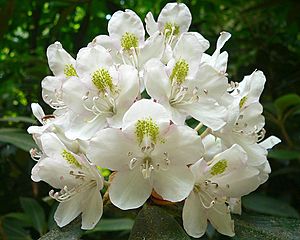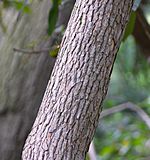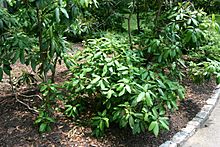Rhododendron maximum facts for kids
Quick facts for kids Rhododendron maximum |
|
|---|---|
 |
|
| Flower cluster | |
| Conservation status | |
| Scientific classification | |
 |
Rhododendron maximum is a type of plant often called the great laurel or rosebay rhododendron. It is a large shrub that grows naturally in the Appalachian Mountains of eastern North America. You can find it from Alabama all the way north to coastal Nova Scotia.
Contents
What it Looks Like
The Rhododendron maximum is an evergreen shrub. This means its leaves stay green all year round. It usually grows about 4 meters (13 feet) tall, but sometimes it can reach 10 meters (33 feet)!
Its leaves are long, about 9–19 centimeters (3–8 inches). They are also quite wide, around 2–4 centimeters (0.75-1.5 inches). The leaves are thick and waxy, and they can stay on the plant for up to 8 years. However, once they fall off, they break down very slowly.
The plant produces pretty flowers that are about 2.5–3 centimeters (1 inch) across. They can be white, pink, or light purple. Often, they have small greenish-yellow spots. These showy flowers appear in June and July.
After the flowers, the plant makes a dry capsule that is 15–20 millimeters (0.60-0.79 inches) long. This capsule holds many tiny seeds. Be careful, though, because the leaves of this plant can be poisonous.
Where it Grows
The rosebay rhododendron is the most common type of Rhododendron in the southern Appalachian region. It also grows in other damp, hilly areas across the southeastern United States.
Ecology
This plant covers a huge area in the southern Appalachians, about 12,000 square miles! It often grows under taller trees.
It likes deep, well-drained soil that is rich in organic matter and a bit acidic. It grows best in places with low to medium sunlight.
Sometimes, if many of the taller trees in a forest die, the rosebay rhododendron can grow very thick. It forms a dense layer that locals call 'laurel slicks' or 'laurel hells'. This plant is a very important part of the forests in the southern Appalachians.
Scientists are still studying if this plant is spreading or shrinking. For example, in some high-up areas, many rosebay rhododendrons have died. This might be because of a fungus or long dry periods. But in other places, it is now growing where it never used to.
Reproduction
Rosebay rhododendron can make copies of itself in two ways:
- Vegetative Reproduction: This means it can grow new plants from its own parts. It does this through a process called 'layering'. If a branch touches the ground, it can grow roots and start a new plant. This is the most common way it spreads, creating groups of identical plants.
- Sexual Reproduction: The plant also produces seeds. Its showy flowers turn into an oblong capsule. This capsule ripens in the fall and then splits open. It releases many tiny seeds, about 400 from each capsule. These seeds need special conditions to grow, like rotting logs, so most new plants come from layering.
Growth and Management
The seeds of the rosebay rhododendron are very small. About 11 million seeds can fit into 1 kilogram! However, seeds from wild plants are not usually sold. Most seeds for growing are from special types of rhododendrons.
This shrub grows slowly. But if you try to remove it, it can grow back very quickly and become even thicker in just a few years. People have also tried to use controlled fires to manage it, but this has not been very successful.
Benefits
The rosebay rhododendron is a beautiful plant that adds a lot to the forests of the southern Appalachians. It is one of the largest and toughest rhododendrons grown for sale. Many different types with white to purple flowers have been chosen for gardens.
When it grows naturally, it has lovely white, pink, or light purple flowers. These usually bloom in June, but can appear from March to August. Its deep-green leaves stay all year round. This plant also helps protect steep hillsides and provides shelter for wildlife. Its wood is very hard and is sometimes used for special wood products.
Detrimental Effects
Even though the rosebay rhododendron is beautiful, it can sometimes stop other plants from growing. Some people think that because there are fewer fires and less grazing by animals, this plant has spread into new areas.
When it grows in these new places, it can make it harder for other trees and plants to grow. This is because it might take up too much light or other important things from the soil. Scientists are still studying exactly how it affects other plants.
Alternate Common Names
R. maximum is also known by these names:
- Great rhododendron
- Late rhododendron
- Summer rhododendron
- Great laurel
- Bigleaf laurel
- Deertongue laurel
- Rose tree
- Rose bay
- Bayis
- Mountain laurel
Symbolism
Rhododendron maximum is the state flower of West Virginia in the U.S.
See also
 In Spanish: Rhododendron maximum para niños
In Spanish: Rhododendron maximum para niños





